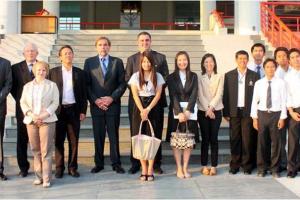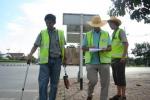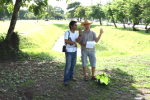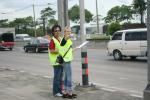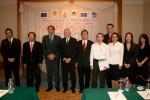Thailand Accident Research Center
ศูนย์วิจัยอุบัติเหตุแห่งประเทศไทย
Improving Road Traffic Safety in Thailand: A Common Challenge for European and Thai Universities
Road accidents have been recognized as a trans-boundary problem with serious negative welfare and economic impacts faced by many countries around the world, including European and Asian countries. In combating this problem, many national and international agencies have set strategic policies to improve road safety situation by targeting gradual decreases in the number and the severity of traffic accidents as their goal.
In an effort to contribute to road safety improvement, four renowned European and Asian universities had successfully joined hands in establishing the EU-Asia Network in Competence Enhancement on Road Safety (NICE on RoadS) under the framework of an EU-funded Asia-Link project in 2005. Through various activities, the partners of this international network have been able to gain comprehensive experiences and skills related to road safety issues. Fostering its contribution to road safety improvement, particularly in Thailand, the network has recently welcomed two renowned academic institutions in Thailand as its new partners, namely Asian Institute of Technology and Thammasat University. The network then carried out several concerted collaborative activities under the EU-funded Action titled Improving Road Traffic Safety in Thailand: A Common Challenge for European and Thai Universities.
The Action was thoroughly implemented in 18 months, starting from December 2008 to August 2010. Organized into 6 main activities consisting of Meeting, Workshop, Research, Training, Publication, and Conference Programs, the Action was successful in achieving its intended objectives.
A sound methodology was developed by the partners of the NICE on RoadS to facilitate effective knowledge exchange between the European and the Asian partners of the network in the field of road safety. The methodology was implemented in developing the guidelines for providing safer intersection design and operations for Thailand. Road intersections were specifically targeted since many critical safety deficiencies that caused severe accidents were located in this particular part of road networks, yet such guidelines were still in absence in Thailand. The methodology was used throughout the research program and proven to work satisfactorily. With this methodology, principal investigators and research assistants from all parties in the network were able to work together, identify and overcome gaps, exchange knowledge, share experiences, and finally produced the guidelines through intensive cooperation and collaboration.
The guidelines on roundabout design and on signalized intersection design were the main results of this collaborative research. The roundabout design and signalized intersection design guidelines were developed based on the Hungarian and the German experiences, respectively, adapted to Thai traffic behavior and road system. A series of extensive field investigations on selected road intersections across Thailand and numerous desk studies had been conducted in the research program. Involvement of the researchers from all participating universities ensures that the developed guidelines were adaptable to the Thai context and conditions.
During the development process, key government offices, related academic institutions as well as professional associations were also consulted in a series of workshop and conference programs. These programs were conducted to gain feedbacks and inputs related to the guidelines and their implementation from different viewpoints. The Action also organized two training courses namely Summer School and Winter School, conducted at Asian Institute of Technology and Thammasat University, respectively. The schools facilitated the introduction of the developed guidelines to local experts and stakeholders dealing with road safety improvement in Thailand. Finally, the introduction of the two design guidelines at the final conference of the Action received high appreciation and anticipation from various stakeholders, such as Ministry of Transportation, Bangkok Metropolitan Administration, Department of Highways, Royal Police Department and Department of Rural Roads. Some Thai universities had also shown interest to conducting further research studies related to the newly introduced guidelines.

